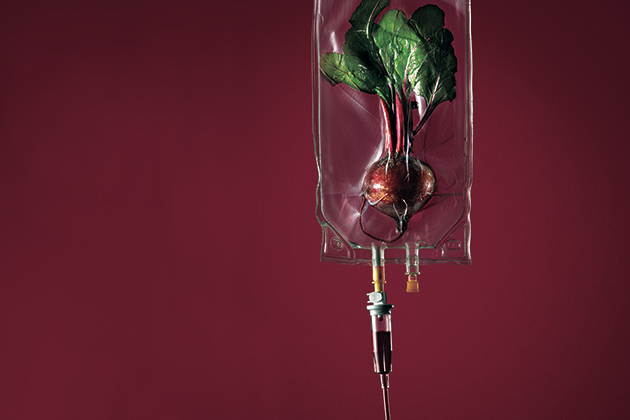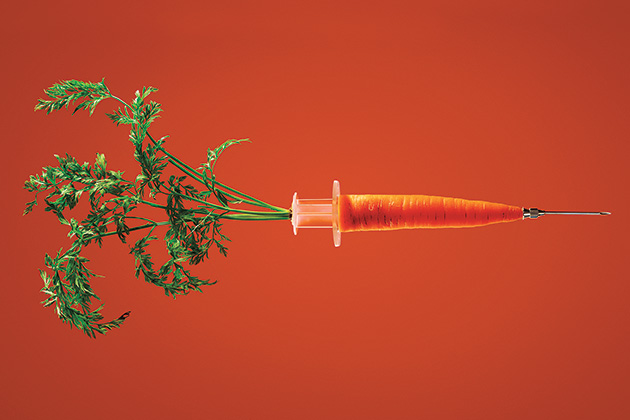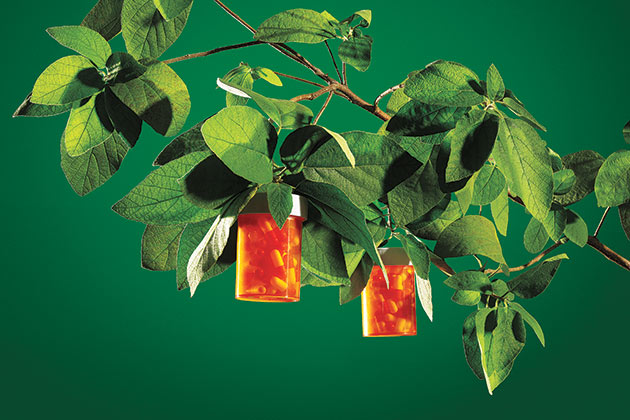Published On February 12, 2016
THE EBOLA CRISIS SWEPT THROUGH West Africa in 2014, leaving more than 11,000 dead. Those who were infected with the virus faced a 50/50 chance of dying, without hope of pharmaceutical remedy. An untested treatment, however, was flown in from a lab in San Diego to treat nine deathly ill missionaries and health workers, under special “compassionate use” guidelines. And while part of the legacy of the drug, named ZMapp, may be its promise as a cure—seven of the nine patients who received the experimental drug survived—a footnote in its creation tells the story of a new, perhaps even more exciting, frontier. Each dose of ZMapp was produced by a tobacco plant.
Why tobacco—and, indeed, why plants? Producing drugs and vaccines in plants has been slowly gaining momentum, and weeding out its own drawbacks, since the 1980s. That’s when a breakthrough involving not plants but rather one-celled organisms—bacteria and yeast—first allowed scientists to produce “recombinant” proteins (made from recombined DNA) for industrial, agricultural and medical use. In 1982, genetic engineers modified genes in bacteria to make human insulin, and they made a hepatitis B vaccine in yeast in 1986.
Charles Arntzen, the founding director of Arizona State University’s Biodesign Institute and its Center for Infectious Diseases & Vaccinology, recalls the excitement scientists felt when they found they could also alter genes in plants. Unlike bacteria and yeast, most plants have multiple cells and cell types, and their machinery for making proteins is much more complex than the single-celled organisms’. Researchers quickly put plant biotechnology to work in producing new agricultural and industrial products—and also created crops that could resist insects and withstand herbicides. These crops became branded as genetically modified organisms, or GMOs, and have been a source of controversy ever since.
But why not, Arntzen thought at the time, put such techniques to work in adapting plants to produce medicines—a concept now sometimes called pharming? Plants naturally accumulate high quantities of proteins in their leaves, fruits, seeds and grains. Couldn’t they use those characteristics, with genetic modifications, to produce drugs efficiently and cheaply?

Over the years, researchers began using specially adapted lettuce, alfalfa, potatoes, carrots, soybeans, rice and even algae to produce therapeutic enzymes, antigens for vaccines, proteins for blood transfusions, growth factors and growth hormones, and they often were able to make large quantities that would be needed to meet high demand.
Advocates of pharming point out that growing plants doesn’t require the costly investment in bioreactors, equipment and chemicals used in traditional drug manufacturing. Plants need only sunshine (or artificial light), soil, water and nutrients. They can grow indoors, in a greenhouse, in fields or, in the case of algae, in plastic bags, aquariums or ponds. They can produce almost any sophisticated protein that mammalian cells can make, and to the delight of drug developers, make more uniform batches of proteins—and often do it faster.
Plants also have a safety advantage. Bacteria, yeast and mammalian cells used to make medicines can become contaminated with viruses or other agents that could cause diseases in humans, but those agents don’t infect plants, and the pathogens that hurt plants generally don’t harm people. Moreover, plant-based therapies could potentially be distributed—as processed pastes, capsules or other oral preparations that didn’t require refrigeration—in poor, rural parts of the world.
Yet despite having a possible edge on other pharmaceutical methods, so far plants have been used mostly in limited roles. The production of more sophisticated drugs—for example, the monoclonal antibodies increasingly used to treat cancer and immune disorders—has been slower to catch on. But the apparent success in producing ZMapp suggests that niche uses of pharming could finally add some forward momentum.
PLANTS THAT PRODUCE DRUGS are versatile in that their production can be scaled up and down, for the cost-effective manufacturing of small or large quantities. Indeed, in 2001, Arntzen proposed that plants with modified genes might be used to churn out massive amounts of a vaccine to fight an emerging pandemic or a bioterrorism attack. And that potential benefit was very much on the minds of those in the medical research arm of the U.S. military following the September 11, 2001, terrorist attacks. In its aftermath, envelopes containing spores of anthrax—an often lethal bacterium—were delivered to government offices. Facing the specter of bioterrorism, the United States Army Medical Research Institute of Infectious Diseases (USAMRIID) granted $3.6 million to Arntzen and his team to develop plant-made vaccines and therapeutics against another dangerous pathogen—Ebola.
As the project evolved, Arntzen envisioned an Ebola treatment consisting of antibodies, complex proteins that the body’s immune cells make to respond to viruses and bacteria. To find Ebola antibodies, Arntzen’s group collaborated with two research scientists, Larry Zeitlin and Kevin Whaley at Johns Hopkins University, who were then founding Mapp Biopharmaceutical, based in San Diego. By 2012, those researchers had determined that three antibodies discovered at USAMRIID protected against Ebola in mice. The next step was to produce enough antibodies to test in combination in rhesus monkeys, which develop a more human-like form of Ebola.
There are three standard choices for making drug proteins—bacteria, yeast or mammalian cells, says Stephen Mayfield, professor of molecular biology at University of California, San Diego. It’s easy to manipulate bacteria and to grow them in fermentation tanks, but bacteria aren’t sophisticated enough to make antibodies. Bacteria can’t assemble the complex proteins, fold them into functional forms or produce antibodies that retain their biological activity in the body. Yeasts can do that, but they add too many extra sugar molecules to proteins, which change how the antibodies behave. Mammal cells—often Chinese hamster ovary (CHO) cells—work well for this purpose and have become the pharmaceutical industry’s go-to option for manufacturing antibodies. “But CHO cells are finicky,” says Mayfield. They have to be grown in expensive bioreactors using costly chemicals, growth factors and nutrients, and it’s very time-consuming to set up a system to produce them.
Plants’ protein-making machinery, however, is similar to that of the body’s immune cells, called lymphocytes, that naturally make antibodies. “So we saw the potential for making antibodies more quickly and cheaply than in mammalian cells,” Arntzen says. And the ideal plant, he reasoned, was tobacco.
Thanks to its long history as a lucrative cash crop for cigarette manufacturers, tobacco had been thoroughly studied, with its genes catalogued, and the same was true of the bacteria and viruses that attack tobacco plants. Also, the same prolific biological processes that normally generate tars and nicotine can be co-opted to produce high yields of beneficial proteins. Researchers can use a bacterium that normally infiltrates plant leaves to ferry in genes that will create recombinant proteins with a medicinal use. Tobacco leaves begin producing those proteins within days or weeks, whereas it takes many months or sometimes years to get a traditional drug production facility up and running.
Mapp contracted with Kentucky BioProcessing in Owensboro, Ky., to produce antibodies in Nicotiana benthamiana, a tobacco species not used to make cigarettes. Kentucky BioProcessing had previously met a Department of Defense test challenge, successfully producing enough antigens in tobacco for over one million doses of flu vaccine in 30 days. Now, to make the Ebola cocktail, the company grew tobacco plants from seeds in trays under artificial light in a climate-controlled facility. After about three weeks, when the plants were a foot high, they were “transformed” with a modified plant bacterium, Agrobacterium tumefaciens, that carried the gene for one of the needed antibodies. The modified bacterium caused the plant to begin expressing the antibody, which grew in the tobacco leaves.
After a week, harvest began. A grinder mashed the leaves into a green juice that had the smell of fresh tobacco. Filtered, the juice became a clear liquid that was further purified. Workers sanitized the equipment and repeated the process for the second and third antibodies. All three were combined for animal testing.

Monkeys that got this three-antibody cocktail (MB-003) survived a dose of Ebola virus that killed untreated monkeys. To validate the tobacco-made process, Mapp treated other monkeys with the same antibodies that had instead been produced in CHO cells. The plant-made antibodies were approximately three times as potent against the virus as the CHO-made ones. Mapp then worked with a Canadian team to select a still more effective combination of antibodies, which became known as ZMapp and was also produced in tobacco at Kentucky BioProcessing.
In early 2014, Mapp had just begun testing monkeys with ZMapp when the Ebola outbreak in West Africa rapidly escalated. But with two American missionaries, Kent Brantly and Nancy Writebol, near death from Ebola infections, Samaritan’s Purse (the missionaries’ sponsor) requested ZMapp in a last-ditch effort to save their lives. “It was nerve-wracking to have the first human test be on someone who was just about to die from Ebola,” Zeitlin says. “We expected ZMapp to be useful, but not so late in infection.” Both patients fully recovered, though it’s not yet known whether the drug or other factors in their care made the difference.
“If we had used CHO cells instead of tobacco plants to produce the antibodies, we wouldn’t have had any drug to provide for compassionate use to patients in 2014,” Zeitlin says. And without the 2014 Ebola outbreak, it might have taken several years before ZMapp was approved for human testing. Now, Kentucky BioProcessing is producing ZMapp for clinical trials in Africa, sponsored by the National Institute of Allergy and Infectious Diseases (NIAID), which may lead to its approval.
ZMAPP’S APPARENT validation of pharming has yet to lead to a surge of plant-made drugs. Some promising candidates are waiting in the wings. UCSD’s Mayfield, for example, has developed a method that he believes could cheaply produce two anti-cancer compounds as well as a malaria vaccine in the green algae Chlamydomonas reinhardtii. Yet while he thinks the drugs are ready for human studies, lack of interest from the pharmaceutical industry has put them on hold.
It’s seemingly not enough for plant-made pharmaceuticals to show proof of principle, demonstrating in animals that they can effectively treat or cure a disease. They must also show proof of practicality—that it makes economic sense for a company to try to gain regulatory approval for a new method of production. Arntzen notes that large pharmaceutical companies have invested heavily in traditional production methods that have already met arduous regulatory standards. Clearing new government hurdles for an alternative production method is a daunting prospect.
“When more plant-made drugs have received regulatory approval, that will create a path for others to follow,” says Hugh Haydon, head of Kentucky BioProcessing. “Until then, we need to focus on where plants have a real edge. I don’t think plants will supplant or even compete with traditional methods, but they can be a sensible option when speed, flexibility and scale are at issue.”
That speed comes in handy when companies begin developing a drug. That process, says Haydon, requires first producing small quantities for laboratory tests or animal studies. And obtaining such minute amounts in a bioreactor geared to produce hundreds of thousands of doses at a time is an inefficient use of resources. Likewise, in “precision” medicine, in which a one-off drug or vaccine may be tailored to a patient’s tumor or immune system, patients need just a tiny amount of a drug, and often just for a short time. Orphan drugs designed to treat rare diseases might also be more cost-effectively produced in plants.
In fact, treating Gaucher disease, a rare disorder involving an enzyme deficiency, is a sort of poster child for small-scale production—as well as for the relative safety of plants. The biotechnology company Genzyme had been producing a treatment—the replacement enzyme, Cerezyme—in CHO cells until 2010, when its facility became contaminated with potential human pathogens and had to be shut down.
Although seldom seen in the United States, Gaucher disease is more common in Israel, among Ashkenazi Jews. As an alternative to Cerezyme (which costs patients $200,000 per year), the Israeli company Protalix used plants to develop a lower-cost “biosimilar,” a kind of generic for biological drugs—those made in living organisms rather than synthesized chemically. Protalix grew the replacement enzyme in cultured carrot cells, which are cheaper and much less susceptible to contamination than CHO cells. In 2012, the company licensed its drug, Elelyso, to Pfizer, marking the first time a major U.S. pharmaceutical firm got involved in plant-cell pharming.

And using carrot cells to produce the drug had a bonus benefit. It added sugars to the protein—a process called glycosylation—in a different configuration than the CHO cells did, and that serendipitously produced an enzyme that is more active than that made in CHO cells. Mapp Biopharmaceutical also traced the superior performance of tobacco-made Ebola antibodies to differences in glycosylation, and pharming researchers are now exploring whether that could be an advantage in producing other therapeutic compounds.
Meanwhile, Mayfield hopes to sidestep some regulatory hurdles for plant-made products by focusing on over-the-counter “nutriceuticals,” which don’t require the same FDA scrutiny as prescription drugs do. He is using green algae to produce colostrum proteins, a widely studied group of proteins present in the early breast milk of all mammals that activates a newborn’s immune system to handle the onslaught of pathogens it will encounter. He wants to introduce the oral supplement in the United States for relieving diarrhea and symptoms of inflammatory bowel syndrome. “If we have a track record of safety and efficacy in the first world, we can introduce it in the third world, where five million children die yearly from diarrhea, more than from any other disease,” Mayfield says.
INDEED, PHARMING COULD potentially have its biggest impact in the developing world. In the 1980s, Arntzen had aimed for plant-made edible vaccines and medicines. What if a child simply ate an antigen-laden banana to get protection against deadly, endemic diseases? It was a naïve notion, he realizes now, because vaccines and medicines must have consistent doses and standardized quality, requiring some processing for plant-made drugs. Still, plants accumulate their proteins in convenient tissues—leaves, fruits, seeds, kernels and roots—that can be dried, stored and delivered, in prepackaged standardized doses, without refrigeration. That makes them enticing candidates for large, isolated swaths of the world that lack refrigeration or efficient health care services. “The ideal vaccine or treatment wouldn’t need a cold chain, and it wouldn’t need to be injected—so that you wouldn’t need trained clinicians to deliver it,” Mayfield says. It would be even better if local farmers could grow the plants and local industries could process them for distribution. But so far, the World Health Organization and other philanthropic organizations funding medicines and vaccines for such diseases have not embraced plant-made technologies.
In the end, the greatest barrier to the widespread adoption of pharming may be procedural inertia. Pioneering a new way to produce therapies and vaccines means evolving regulatory approvals, and that can take time. Meanwhile, the U.S. military’s research programs are still interested in plant-made vaccines for epidemics and pandemics. So, just as defense research dollars have funded many innovations that civilians now can’t live without (the internet and GPS, to name two), perhaps someday pharming will become more of a household word, especially in key niche areas like early drug discovery, orphan drugs and personalized medicines.
Dossier
“Plant Molecular Pharming for the Treatment of Chronic and Infectious Diseases,” by Eva Stoger et al. Annual Review of Plant Biology, April 2014. This review discusses applications of plant biotechnology, including bioterrorism, personalized medicines and others.
“Production of Unique Immunotoxin Cancer Therapeutics in Algal Chloroplasts,” by Miller Tran et al., Proceedings of the National Academy of Sciences of the United States of America, January 2013. Complex anticancer therapeutic and personalized treatments for B-cell lymphomas can be produced in algae.
“Dried-Leaf Artemisia Annua: A Practical Malaria Therapeutic for Developing Countries?”, by Pamela Weathers et al., World Journal of Pharmacology, December 2014. Researchers look at uses for the plant artemisia, the source of antimalaria compounds.
Stay on the frontiers of medicine
Related Stories
- An Apple a Day
Adding or tweaking genes can improve the nutritional value of everyday foods.
- Testing the Waters
The ocean floor is teeming with microorganisms that may hold the secret to new treatments for cancer and other diseases.
- An Outbreak Told in Genomes
Rapid genetic sequencing maps an Ebola outbreak in fine detail.